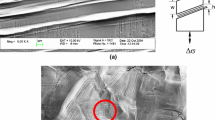Abstract
A scanning laser crack detection technique has been developed for use in corrosion fatigue testing of fine metallic wires. The technique has been integrated into a computerized data acquisition and control system allowing the unattended operation of extended fatigue tests. The system is capable of detecting cracks with surface lengths as small as 100 μm, with crack opening displacements as low as 1 μm. Detection schemes of light loss and light scattering have been successfully used to monitor crack initiation in air and in 0.9% sodium chloride solution. The present scanning laser system has been used for crack initiation detection in over 50 fatigue experiments and has the potential for use in crack growth monitoring. The method can provide information concerning other surface phenomena in addition to the study of cracks. The technique has potential applications beyond metallic wires, including fibers used in optics and ceramic reinforcement fibers used in structural composites.
Similar content being viewed by others
References
ASTM E 466–82, “Standard Practice for Constant Amplitude Axial Fatigue Tests of Metallic Materials” (American Society for Testing and Materials, Philadelphia, PA, 1982).
ASTM E 647–93, “Standard Test Method for Measurement of Fatigue Crack Growth Rates” (American Society for Testing and Materials, Philadelphia, PA, 1993).
B. Krams and L. Raymond, Report to Baxter Healthcare No. BXT 90295-2e, part 5 (1990), pp. 69–88.
O. Vosikovsky, Canadian Metall. Quarterly 19, 87–97 (1980).
F. D. Bogar and T. W. Crooker, NRL Report 8253, Naval Research Laboratory, Washington, DC, October 7 (1977).
J. E. Shigley and C. R. Mischke, Mechanical Engineering Design (McGraw-Hill, New York, 1989), pp. 65–70.
J. Buerkle, D. Dunn-Rankin, K. Bowo, and J. C. Earthman, Materials Evaluation, June, 670–677 (1992).
J. Buerkle, D. Dunn-Rankin, K. Bowo, and J. C. Earthman, in Proc. American Society of Nondestructive Testing Annual Conference, Oakland, CA, March 18–22 (1991), pp. 156–158.
Author information
Authors and Affiliations
Rights and permissions
About this article
Cite this article
Schmidt, P.A., Earthman, J.C. Development of a scanning laser crack detection technique for corrosion fatigue testing of fine wire. Journal of Materials Research 10, 372–380 (1995). https://doi.org/10.1557/JMR.1995.0372
Received:
Accepted:
Published:
Issue Date:
DOI: https://doi.org/10.1557/JMR.1995.0372




